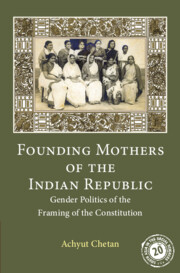Book contents
- Frontmatter
- Dedication
- Contents
- List of Images
- Preface
- Acknowledgements
- List of Abbreviations
- Introduction: Towards a Feminist Reading of the Making of the Constitution
- 1 In the Shadow of the Founding Fathers
- 2 In Search of the Missing Mothers
- 3 Women’s Moral Imaginary and Constitutional Politics: 1927–1946
- 4 Patterns of Participation: Women Members in the Constituent Assembly
- 5 Writing the Rights: Inscribing Constitutional Morality
- 6 Reformulating the ‘Woman Question’: Challenging Customs and Traditions
- 7 After the Framing
- Conclusion: Remembering the Founding Mothers
- Appendix: Texts and Contexts of the Framing – A Timeline
- Bibliography
- Index
Appendix: Texts and Contexts of the Framing – A Timeline
Published online by Cambridge University Press: 27 September 2022
- Frontmatter
- Dedication
- Contents
- List of Images
- Preface
- Acknowledgements
- List of Abbreviations
- Introduction: Towards a Feminist Reading of the Making of the Constitution
- 1 In the Shadow of the Founding Fathers
- 2 In Search of the Missing Mothers
- 3 Women’s Moral Imaginary and Constitutional Politics: 1927–1946
- 4 Patterns of Participation: Women Members in the Constituent Assembly
- 5 Writing the Rights: Inscribing Constitutional Morality
- 6 Reformulating the ‘Woman Question’: Challenging Customs and Traditions
- 7 After the Framing
- Conclusion: Remembering the Founding Mothers
- Appendix: Texts and Contexts of the Framing – A Timeline
- Bibliography
- Index
Summary
1906 Dadabhai Naoroji demands self-government
1909 Morley–Minto Reforms establish a parliamentary system in India
1914–1918 World War I
1917 The Montagu–Chelmsford Report visualizes India as a self-governing sisterhood of states presided over by a Central Government
1919 Massacre at Amritsar
December 1920 Congress resolution on the Non-coperation Movement in the Nagpur session
1919 The Government of India Act
1925 The Commonwealth of India Bill
1927 Foundation of the All India Women's Conference (AIWC)
1929 The Child Marriage Restraint Act
1930–1932 Round Table Conferences
26–31 March 1931 Resolution on Fundamental Rights passed by the Congress in its Karachi session
1932 Poona Pact between Gandhi and Ambedkar
24 November 1934 Legal Disabilities Day announced by the AIWC
1935 The Government of India Act
1937 First General Election in British India
1937 The Irish Constitution makes a distinction between justiciable and non-justiciable rights
1938 National Planning Committee established by the Indian National Congress
1939 Sub-Committee on Woman's Role in Planned Economy appointed
1939–1945 World War II
1942 Visit of Sir Stafford Cripps; Cripps’ proposal that a constitution-making body be set up in India fails. This is the first recognition by the British of the need for a Constituent Assembly.
1943 Renuka Ray nominated to the Central Assembly (Legislative)
1944 Renuka Ray invited as special member of the Hindu Law Committee
1945 General Elections in Britain; Labour Government formed with Clement Attlee as Prime Minister
December 1945 Draft of the Indian Women's Charter of Rights and Dutie
16–18 February 1946 16 February: Two commissions formed: a Commission on Human Rights and a Sub-Commission on the Status of Women. 18 February: Amrit Kaur elected as a member of the Sub-Commission on Human Rights. However, Amrit Kaur was replaced by Hansa Mehta who attened the inaugural sessions of the Sub-Commission on Human Rights in New York from 29 April 1946 to 13 May 1946. When Mehta, later, moved to the Commission on Human Rights that drafted the UDHR, she was replaced by Hamid Ali on the Sub-Commission on the Status of Women.
- Type
- Chapter
- Information
- Founding Mothers of the Indian RepublicGender Politics of the Framing of the Constitution, pp. 287 - 291Publisher: Cambridge University PressPrint publication year: 2023

